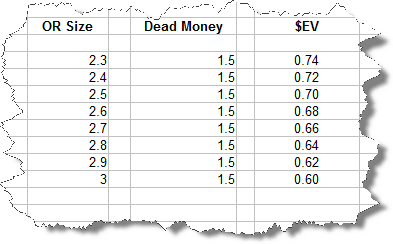Chaos Theory In Poker
(by: SplitSuit)
.
Chaos theory has always interested me. It is most commonly referred to as “butterfly effect”, and revolves around mathematical anomalies that can create chaotic results in the long run of a system. The wiki definition is this:
.
“Chaos theory is a field of study in mathematics, physics, economics and philosophy studying the behavior of dynamical systems that are highly sensitive to initial conditions. This sensitivity is popularly referred to as the butterfly effect. Small differences in initial conditions (such as those due to rounding errors in numerical computation) yield widely diverging outcomes for chaotic systems “
.
Because I am always interested in finding applications for anything in anything, I wanted to talk a little about how chaos theory can be used in poker. This article will be a bit more theoretical than some of my other pieces, but should still help you visualize some things that we may, or may not, take for granted in a strategic sense. Due to chaos theory dealing so much with initial conditions that create chaos for our results, we can view chaos theory in two different ways in poker:
.
1.) Initial inputs can create major chaos in a strategy
2.) Stat rounding-errors can create major chaos in $EV
.

.
Let’s first talk about initial inputs creating chaos. We deal with many inputs when making plays and creating lines in poker. Everything from tangible inputs such as our hand value and our opponent’s CC%, to intangible inputs such as our opponent’s tilt level. Any inaccuracies of any input can drastically alter the validity and/or profitability of a line. Let’s look at a few examples:
.
1.) Charlie opens from MP and we see over 900 hands he is running 13/11 with an MPPFR of 10%. But maybe Charlie is tilting and his MPPFR in this hand is 18%. Or maybe he is a little tired and his MPPFR in this hand is actually 7%. Yes, his MPPFR overall is 10%, but that doesn’t mean his MPPFR in this singular hand is 10%. Maybe he is trying to LAG today…or maybe he is trying to tighten up from MP. These are all inputs that we wouldn’t really be very privy to, but being inaccurate could drastically change our line and actual $EV of that line.
.
2.) We are at a very aggressive table and decide to open AQ from UTG. While AQ might be a good open from EP as a standard, this might not be the right table to do it. We will probably get 3bet a lot and have to fold, or if we get called, we probably will have a tough time winning the pot from OOP at such an aggro table. This minor inaccuracy in PF hand selection can create major chaos in our profitability given that there are so many more decisions to make and money to risk…and even a very small mistake now can create massive mistakes later.
.
3.) The same can be said for mistakes made on the flop. By making an ill-advised CB, or using a bad CR size, we can drastically alter our profitability. In certain spots, a CB can actually take a play from really good to being really bad. For instance, say we resteal with 86s and get called by a player who would only call a resteal with TT+. While the 3bet might have been outright profitable, making a CB on a 942 board can be disastrous versus this player. Many players make a good play early in the hand (an outright profitable 3bet, a good steal, or even a good open raise), and then botch it up with flop play that makes the hand a losing endeavor.
.
.
Because mistakes made in NL and PL games can be so drastically compounded based upon stack depth, it is very important that we always have our initial inputs very solidified. Everything from hand selection, to our CC range, to our sizing, to our CB on a board, to our turn play with a SDV/value hand. This is why beginning players should be encouraged to play a tighter range of hands from all positions PF. It keeps them out of trouble, keeps their range stronger, and lessens the number of odd single pair spots that will come up postflop. We should always keep a big eye on initial inputs, thus why we focus the most on our PF play, then our flop play, and onwards.
.
The next way we can use chaos theory in poker is considering statistical discrepancies that can alter the profitability of a play. Every stat we use on our HUD rounds to some extent, and those errors can create massive chaos in a system. Also, little things like PokerStove can create rounding-errors as well. If our short-hand methods of doing quick math also have rounding-errors, then the math on a given play can yield totally different results based on which way we rounded.
.
We see simple rounding-errors everywhere. For instance, the odds of getting dealt AA PF are 220:1. Most pieces of software tend to round this to .5% (go plug AA into PokerStove, you will see what I mean). Other sources round it to .45%, which is more correct than .5%. But an even more correct number is .45248868778280542986425339366516%. While this might not seem like a massive rounding-error, it can change a lot of things in an $EV equation. Let’s look at an example:
.
Say we know our opponent raises 22+ (we’ll simplify it to this just so things don’t get too complex). This would be 5.8823529411764705882352941176471% of hands (we already have a rounding-error here for the record because my calculator won’t do more decimal places). We are considering 3betting this player assuming that he folds 22-99 and continues with TT-AA. Let’s look at the simple and complex math:
.
Simple: (22-AA = 5.9%)(22-99 = 3.6%)(TT-AA = 2.3%)
.
2.3%/5.9% = 40%. Which means 60% of his range folds
.
Complex: (22-AA = 5.8823529411764705882352941176471%)(22-99 = 3.60962566844919786096256684492%)(TT-AA = 2.2727272727272727272727272727273%)
.
2.2727272727272727272727272727273%/5.8823529411764705882352941176471% = 38.636363636363636363636363636359% (meaning that 61.36363636363636363636363636365% of his range folds)
.
Say he opens to $3 at 100NL. We decide to 3bet to $6 from the button still assuming that he folds 22-99 always, and only continues with TT-AA. Here is the outright $EV in both simple and complex form:
.
Simple:
.
($4.5*.6) – ($6*.4) = +$0.30
.
Complex:
.
($4.5*. 6136363636363636363636363636365) – ($6*. 38636363636363636363636363636359) = +$0.443181818181818181818181818184
.
So between the simple and complex forms we have a $0.143181818181818181818181818184 difference. Let’s say over a 100K hand sample size this kind of situation arises 250 times. This means that there is a ~$35.8 (.02PTBB/100 on our winrate) difference in a bigger sample’s $EV. And if this kind of spot game up 1K times in that 100K sample it would be a little less than 1.5BI (.07PTBB/100) differential from this singular situation.
.
The same math can be done for open raise sizing. Say we are thinking about stealing and we think our opponent will fold 80% of the time, and when he continues we lose (again, we have to hyper-simplify these situations because the compounded decisions make talking about flop/turn/river considerations too complex for this type of article). Let’s say we are considering the $EV between open raising to $2.3 and $3. Let’s look at some basic math:
.

.
We see a simple change of .1BB makes a .02BB differential in outright profitability. Say we were considering using $2.5 v $3 as our steal size in this situation over a 100K sample size, and that this situation comes up 750 times in 100K hands. That would make for a $75 differential over a 100K sample size. This is relatively massive (.04PTBB/100). But if we use $2.3 instead? Now, versus a $3 steal size, we could be saving $105 over 100K hands (.05PTBB/100). These little sizes can add up in a big way, especially when we consider how often situations like these arise over our poker life time.
.
While we could talk about bet sizing forever, we can also look at things like rounding-errors in our HUD. Take a Resteal% of our opponent with no decimal points being shown. This means that our HUD might show our opponent to have an 8% resteal, but his “real” resteal is somewhere between 7.5% and 8.4%. While it may not seem like a massive differential, it is relatively massive when we we think about it. Say we are playing and steal for $2.5, he resteals to $9 from the BB, and we know he would always fold versus a 4bet unless he has KK+. We decide to 4bet to $22 and run the $EV against each Resteal% he could have:
.

.
We see that there is a ~$.4 differential between him having a 7.5% resteal and an 8.4% resteal. If this spot happens just 100 times over a 100K sample size we are talking about a $40 (.02PTBB/100) outright differential from this singular spot. And these situations are everywhere. From CB% to FoldvFlopCR, to W$aSD and EPPFR. These little rounding-errors can change our profit in big ways, and they happen in just about every single play that we make.
.
**************
So after writing all of that, what can we take away from this? The most important way to consider chaos theory in our game is to think about our initial inputs in a system. While the math is important and should certainly be worked out off the table (especially open raise sizes, 3bet sizes, 4bet sizes, CB sizes, etc.), thinking about actions on the table is going to help out real-time decisions much more. We want to make sure we are only inputting good actions and lines into our strategy to ensure we are as +EV as possible. PF hand selection, solid understand of 3bet spots, and CBing situations are vital to our success because these spots happen the most often and mistakes in them can create exponential losses later in the hand.
.
Make sure to consider chaos theory when trying to look at poker from another angle. While it is certainly called a theory for a reason, extrapolating from it can help us reshape our strategy from a general and mathematical sense. And with that said, go do some math and think about your poker strategy. Good luck out there, and happy grinding!
.
*SS*


So, I’m not trying to be a douche and I like the blog, but it kind of pisses me off to see math abused like this. I don’t see how chaos theory has any place in this article beyond making a cool sounding title.
The first part basically just says that poker is dynamic and don’t rely too much on your HUD. Common sense.
In the second part, you discuss “statistical discrepancies,” in other words, rounding error. I don’t see why this even matters since there is no way to adjust for it. You try to show what an effect this has by saying maybe it happens 250 times or maybe 1000 (complete guesses). BUT, in a 100k sample, there will also be many other hands that have the opposite effect. Positive and negative rounding error, not just one way. In any case, the one example provides no way of estimating the total effect of rounding, or why it is even important to consider… All I can think of is for FGators to deny the accuracy of his EV line.
The stealing example does not take into consideration that his fold % depends on our bet size. If you assume he always folds 80% regardless of our open raise size, we should just minraise every time. Making such an assumption takes all meaning out of the calculation.
Finally, the restealing example. Again, over a 100k sample, some might be 7.6 and others might be 8.4, they wont all be too high or too low. So, the error doesn’t just add up one way. Also, you calculate the effect of error by the EV difference of 7.5% and 8.4%. This is wrong. If you always use the rounded value of 8%, the maximum possible error is less than $.24, and it is usually less than that. Still, though, I don’t see the purpose of this analysis unless you make all of your decisions using an EV calculator and imprecise values.
Really, I enjoy some of the other stuff you write, but this article is so lacking in substance that I felt compelled to sink even more of my time into writing a comment. Looking forward to any response.
like i said…chaos theory doesn’t actually have much actual usage when it comes to the math side (except from a total theoretical and effectively useless POV). the way it is useful is thinking about dynamics and how initial inputs (in terms of actions rather than actual math) can create dramatic differences in results.
This article isn’t the end-all to chaos theory, ldo. I just had some thoughts on the subject and decided I would try writing about them. There are too many mathematical variables (some dependent and others independent) for me to even try doing full $EV analysis on things as “simple” as say, stealing. So I did my best to show how a singular variable could be looked at, and how rounding errors can effect it.
Thanks for the comment though
*SS*